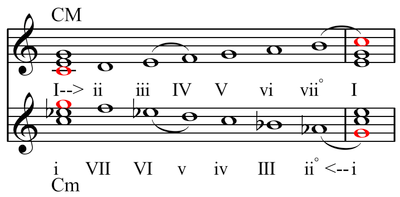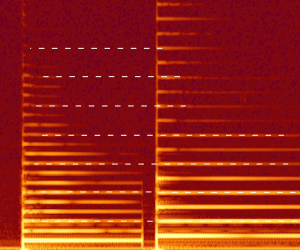Undertone series

In music, the undertone series is a sequence of notes that results from inverting the intervals of the overtone series. While overtones naturally occur with the physical production of music on instruments, undertones must be produced in unusual ways. The overtone series being based on harmonic division, the undertone series is based on arithmetic division.[1]
Methods for producing an undertone series
The overtone series can be produced physically in two ways—either by overblowing a wind instrument, or by dividing a monochord string. If a monochord string is lightly damped at the halfway point, then at 1/3, then 1/4, 1/5, etc., then the string will produce the overtone series, which includes the major triad. If instead, the length of the string is doubled in the opposite ratios, the undertones series is produced. Similarly, on a wind instrument, if the holes are equally spaced, each successive hole covered will produce the next note in the undertone series.
In addition, José Sotorrio showed that undertones could be made through the use of a simple oscillator such as a tuning fork. If that oscillator is gently forced to vibrate against a sheet of paper "it will naturally make contact at various audible modes of vibration."[2] Sotorrio explained that since the tuning fork produces a sine tone, it will normally vibrate at the fundamental frequency (e.g. 440 Hz), but "momentarily", it will make contact only at every other oscillation (220 Hz), or at every third oscillation (147 Hz), and so on. This produces audible "subharmonic spectra", (e.g. below A@440 Hz (1/1), A@220 Hz (1/2), D@147 Hz(1/3), A@110 Hz(1/4), F@88 Hz(1/5), and so on). Sotorrio claims it is possible to sustain these "subspectra" using a sine wave generator through a speaker cone making contact with a flexible (flappable) surface, and also on string instruments "through skillful manipulation of the bow", but that this rarely sustains noticeably beyond the "sub-octave or twelfth".[2]
Comparison to the overtone series

Notes in the series
In the overtone series, if we consider C as the fundamental, the first five notes that follow are: C (one octave higher), G (perfect fifth higher than previous note), C (perfect fourth higher than previous note), E (major third higher than previous note), and G (minor third higher than previous note).
The pattern occurs in the same manner using the undertone series. Again we will start with C as the fundamental. The first five notes that follow will be: C (one octave lower), F (perfect fifth lower than previous note), C (perfect fourth lower than previous note), A ♭ (major third lower than previous note), and F (minor third lower than previous note).
Triads
If the first five notes of both series are compared, a pattern is seen:
- Overtone series: C C G C E G
- Undertone series: C C F C A♭ F
The undertone series in C contains the F minor triad. Elizabeth Godley argued that the minor triad is also implied by the undertone series and is also a naturally occurring thing in acoustics.[4] "According to this theory the upper and not the lower tone of a minor chord is the generating tone on which the unity of the chord is conditioned."[5] Whereas the major chord consists of a generator with upper major third and perfect fifth, the minor chord consists of a generator with lower major third and fifth.[5] Sotorrio, however, said that since this minor triad is not built under the fundamental (C) but under the fifth below (F), major and minor tonalities cannot be said to grow out of this 'polarity'.[2] For this idea to be true, the minor triad would be formed under the Fundamental (C), or else the major triad would be built on the fifth above the fundamental (G) in the overtone series.
Resonance
Hermann von Helmholtz observed in On the Sensations of Tone that the tone of a string tuned to C on a piano changes more noticeably when the notes of its undertone series (c, F, C, A flat, F, D, C, etc.) are struck than those of its overtones. Helmholtz argued that sympathetic resonance is at least as active in under partials as in over partials.[6] Henry Cowell in "New Musical Resources" (pg 21-23) discusses a "Professor Nicolas Garbusov of the Moscow Institute for Musicology" who created an instrument "on which at least the first nine undertones could be heard without the aid of resonators." The phenomenon is described as occurring in resonators of instruments; "the original sounding body does not produce the undertones but it is difficult to avoid them in resonation...such resonators under certain circumstances respond to only every other vibration producing a half tone.. even if the resonator responds normally to every vibration... under other circumstances the body resonates at only every third vibration...the fact that such underpartials are often audible in music makes them of importance in understanding certain musical relationships...the subdominant... the minor triad."
Importance in musical composition

First proposed by Zarlino in Instituzione armoniche (1558), the undertone series has been appealed to by theorists such as Riemann and D'Indy to explain phenomenon such as the minor chord that the overtone series does not explain.[1] However, while the overtone series occurs naturally as a result of wave propagation and sound acoustics, musicologists such as Paul Hindemith considered the undertone series to be a purely theoretical 'intervallic reflection' of the overtone series. This assertion rests on the fact that undertones do not sound simultaneously with its fundamental tone as the overtone series does.[7]
Harry Partch, on the other hand, argued that the overtone series and the undertone series are equally fundamental, and his concept of Otonality and Utonality is based on this idea.[8] Similarly, Graham H. Jackson in his book The Spiritual Basis of Musical Harmony (2006)[9] suggests that the overtone and undertone series must be seen as a real polarity, representing on the one hand the outer "material world" and on the other, our subjective "inner world". This view is largely based on the fact that the overtone series has been accepted because it can be explained by materialistic science, while the prevailing conviction about the undertone series is that it can only be achieved by taking subjective experience seriously. For instance, the minor triad is usually heard as sad, or at least pensive, because humans habitually hear all chords as based from below. If feelings are instead based on the high "fundamental" of an undertone series, then descending into a minor triad is not felt as melancholy, but rather as overcoming, conquering something. The overtones, by contrast, are then felt as penetrating from outside. With the help of Rudolf Steiner’s work, Partch traces the history of these two series, as well as the main other system created by the circle of fifths, and argues that in hidden form the series are balanced out in Bach's harmony.
Kathleen Schlesinger, in her 1939 book, The Greek Aulos, pointed out that since the ancient Greek aulos, or reed-blown flute, had holes bored at equal distances, it must have produced a section of the undertone series. She said that this discovery not only cleared up many riddles about the original Greek modes, but indicated that many ancient systems around the world must have also been based on this principle.
In 1868, Adolf von Thimus showed that an indication by a 1st-century Pythagorean, Nicomachus of Gerasa, taken up by Iamblichus in the 4th century, and then worked out by von Thimus, revealed that Pythagoras already had a diagram that could fill a page with interlocking over- and undertone series.[10]
References
- ↑ 1.0 1.1 1.2 Nattiez, Jean-Jacques (1990) [1987]. Music and Discourse: Toward a Semiology of Music (Musicologie générale et sémiologue). Translated by Carolyn Abbate (1990). Princeton, N.J.: Princeton University Press. p. 202. ISBN 0-691-02714-5. Undertone series shown on E.
- ↑ 2.0 2.1 2.2 Sotorrio, José A (2002). Tone Spectra -and the Natural Elements of Music. (1st Ed) Spectral Music, 2002.
- ↑ Rehding, Alexander (2003). Hugo Riemann and the Birth of Modern Musical Thought, p.16. ISBN 978-0-521-82073-8. Goes to partial nine, unnumbered.
- ↑ Godley, Elizabeth (October 1952). "The Minor Triad" (GIF). Music and Letters 33 (4): 285–295. doi:10.1093/ml/XXXIII.4.285. Retrieved 2006-09-02.
- ↑ 5.0 5.1 (1893). "Russian Folk-Songs", Music: a monthly magazine, devoted to the art, science, technic and literature of music, Volume 4, p.131. W.S.B. Mathews.
- ↑ Hermann von Helmholtz (1954). On the Sensations of Tone. Dover Publications. p. 47. ISBN 978-0-486-60753-5.
- ↑ Hindemith, Paul (1945) [1937]. The Craft of Musical Composition. translated by Authur Mendel (revised ed.). New York: Associated Music Publishers. p. 78. ISBN 0-901938-30-0.
It seems to me repugnant to good sense to assume a force capable of producing such an inversion. ... [The undertone series] can never have for music the same significance as the overtone series. ... This "undertone series" has no influence on the color of the tone, and lacks the other natural advantages of the overtone series...
- ↑ Partch, Harry (1974) [1949]. Genesis of a Music (second ed.). New York: Da Capo Press. p. 89. ISBN 0-306-80106-X.
Under-number tonality, or Utonality ("minor"), is the immutable faculty of ratios, which in turn represent an immutable faculty of the human ear.
- ↑ Graham H. Jackson, The Spiritual Basis of Musical Harmony, George A. Vanderburgh, Shelburne, ON, Canada, 2006, 196 pp.
- ↑ Adolf von Thimus: Die Harmonikale Symbolik des Altertums, Verlag der M. DuMont-Schaubergischen Buchhandlung, Köln, 1868
| ||||||||||||||||||||||||
